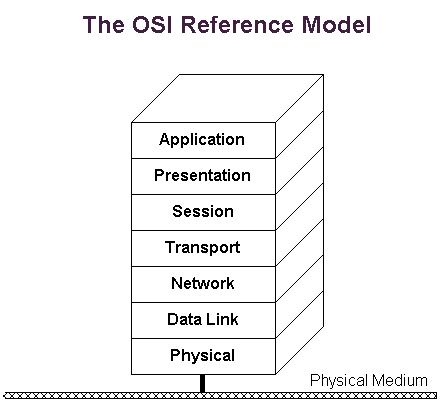
The network architecture is based conceptually on the seven-layer networking model developed by the ISO. Introduced in 1978, the ISO OSI reference model describes networking as a series of protocol layers with a specific set of functions allocated to each layer. Each layer offers specific services to the higher layers, shielding the higher layers from the details of how the services are implemented. There is a well-defined interface between each pair of adjacent layers. The interface defines the services offered by the lower layer to the higher one and how those services will be accessed.

The OSI Reference Model
Network drivers under Windows NT and other Microsoft operating systems that support the Win32 interface fit comfortably within this conceptual framework. Such network drivers implement the protocols and interfaces of the bottom four layers of this network architecture.
The Physical Layer is the lowest layer of the OSI model. This layer is concerned with the reception and transmission of the unstructured raw bit stream over a physical medium. It describes the electrical/optical, mechanical, and functional interfaces to the physical medium. The physical layer carries the signals for all of the higher layers. Under Windows NT, the physical layer is implemented by the NIC, its transceiver, and the medium to which it is attached. For network components that use the serial ports, the physical layer can also include low-level network software that defines how the serial stream of bits is divided into packets of data.
OSI divides the Data Link Layer into two sublayers: LLC and MAC. The LLC sublayer provides error-free transfer of data frames from one node to another. This sublayer is responsible for the establishing and terminating logical links, controlling frame flow, sequencing frames, acknowledging frames, and retransmitting unacknowledged frames. The LLC sublayer uses frame acknowledgement and retransmission to provide virtually error-free transmission over the link to the layers above. The MAC sublayer manages access to the network media, checks frame errors, and address recognition of received frames. Under the Windows NT network architecture, the functions allocated to the Logical Link Control sublayer are implemented in the transport driver, while those allocated to the Media Access Control sublayer are implemented in the network interface card. The NIC is controlled by a software device driver called the NIC driver. Windows NT ships with NIC drivers for a number of popular network interface cards.
The Network Layer controls the operation of the subnet. It decides which physical path the data should take based on network conditions, priority of service, and other factors. This includes routing, traffic control, frame fragmentation and re-assembly, logical to physical address mapping, and usage accounting.
The Transport Layer ensures that messages are delivered error-free, in sequence, and with no loss or duplication. It relieves the higher layer protocols from any concern with the transfer of data between them and their peers. A minimal Transport Layer is required in protocol stacks that include a reliable Network or Logical Link Control sublayer that provides virtual circuit capability. For example, because the Windows NT NetBEUI transport driver includes an OSI-compliant LLC sublayer, its Transport Layer functions are minimal. If the protocol stack does not include an LLC sublayer, and if the Network Layer is unreliable and/or supports datagrams (as with TCP/IP’s IP layer or NWLink’s IPX layer), the Transport Layer should include frame sequencing and acknowledgment, as well as retransmission of unacknowledged frames.
In the Windows NT model, the Logical Link Control, Network and Transport layers are implemented by software drivers known as Transport Drivers (sometimes referred to as protocols, protocol drivers, or protocol modules). Windows NT ships with TCP/IP, IPX/SPX, NetBEUI, and AppleTalk Transport Drivers.